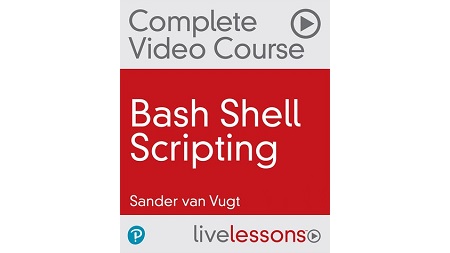
English | MP4 | AVC 1280×720 | AAC 48KHz 2ch | 8h 13m | 8.31 GB
Bash Shell Scripting Complete Video Course, 2nd Edition
Bash is the best way for you to efficiently and effectively execute commands in your daily work. It sounds difficult, but the beauty of Bash is that it is quick, powerful and not particularly complex. Bash Shell Scripting Complete Video Course is a full resource to obtaining the power of Bash. So whether you’re new to shell scripting or an experienced developer, administrator, or user, this course will introduce you to the world of efficient scripting so you can get the job done. This video course consists of 13 lessons in which all concepts that are relevant to Bash shell scripting are explained. It includes demos and exercises throughout that are relevant to Bash Shell scripting; these examples are relevant for anyone using Bash.
This video course was designed to teach through clear training followed by practical examples that show how scripting solutions are being used in the real world. At the end of each lesson you will find an exercise that you should attempt on your own; this is then followed by a video explanation so you can see a real-time walkthrough of the exercise. Doing the work is the best way to learn Bash, and this course provides you with the tools to learn by doing.
Topics include
- Shell scripting fundamentals
- Using conditional statements
- Advanced Bash scripting options
- Real-world scripting examples
Learn How To
- Write Bash script fundamentals
- Write Bash script fundamentals and advanced commands
- Write Bash shell scripts on intermediate and advanced commands
- Write your first hello world shell script
- See how to work with variables
- Use positional parameters
- Apply pattern matching substitution
- Explore looping structures in shell scripts
Table of Contents
1 Bash Shell Scripting Introduction
2 Module introduction
3 Learning objectives
4 Installing Ubuntu Linux
5 Installing Red Hat Linux
6 Using Windows Subsystem for Linux
7 Using the Bash Shell in MacOS
8 Learning objectives
9 Understanding the Role of Bash
10 Using STDIN, STDOUT, STDERR and I O Redirection
11 Using Internal Commands
12 Using Variables
13 Working with alias
14 Using Bash Startup Files
15 Understanding Alternative Shells
16 Understanding Exit Codes
17 Lesson 2 Lab Using Bash
18 Lesson 2 Lab Solution Using Bash
19 Learning objectives
20 What is a Shell Script
21 What is a DevOps Environment
22 Bash and Other Shells
23 Shell Scripts vs. Automation
24 Shell Scripts vs. Python
25 Bash Shell Scripts vs. PowerShell Scripts
26 Lesson 3 Lab Running a Bash Shell in Zsh
27 Lesson 3 Lab Solution Running a Bash Shell in Zsh
28 Learning objectives
29 Using echo
30 Using printf
31 Using Bash Options
32 Using Patterns
33 Using grep
34 Understanding Regular Expressions
35 Using cut and sort
36 Using tail and head
37 Using sed
38 Using awk
39 Considering External Tools and Performance
40 Lesson 4 Lab Using Linux Commands
41 Lesson 4 Lab Solution Using Linux Commands
42 Module introduction
43 Learning objectives
44 Choosing an Editor
45 Shell Scripts and IDEs
46 Core Bash Script Ingredients
47 Running the Scripts
48 Finding Help About Scripting Components
49 Lesson 5 Lab Writing your First Script
50 Lesson 5 Lab Solution Writing your First Script
51 Learning objectives
52 About Terminology
53 Quoting
54 Defining and Using Variables
55 Defining Variables with read
56 Separating Code from Site Specific Data
57 Viewing Variables
58 Handling Script Arguments
59 Using shift
60 Using Command Substitution
61 Using Here Documents
62 Using Functions
63 Lesson 6 Lab Working with Variables and Arguments
64 Lesson 6 Lab Solution Working with Variables and Arguments
65 Learning objectives
66 Working with Parameter Substitution
67 Using Pattern Matching Operators
68 Using Patterns and Extended Globbing
69 Calculating
70 Using tr
71 Lesson 7 Lab Transforming Input
72 Lesson 7 Lab Solution Transforming Input
73 Module introduction
74 Learning objectives
75 Using test
76 Using Simple if Statements
77 Using Logical Tests
78 Testing with [[ ]]
79 Using if…then…else
80 Using if…then‚Ķelse with elif
81 Lesson 8 Lab Using if…then…else
82 Lesson 8 Lab Solution Using if…then…else
83 Learning objectives
84 Applying Conditionals and Loops
85 Using for
86 Using case
87 Using while and until
88 Using break and continue
89 Lesson 9 Lab Using Conditional Statements
90 Lesson 9 Lab Solution Using Conditional Statements
91 Module introduction
92 Learning objectives
93 Working with Options
94 Using Variables in Functions
95 Defining Menu Interfaces
96 Using trap
97 Lesson 10 Lab Writing a Menu
98 Lesson 10 Lab Solution Writing a Menu
99 Learning objectives
100 Understanding Why Arrays are Useful
101 Understanding Array Types
102 Using Arrays
103 Reading Command Output into Arrays
104 Reading Command Output into Arrays – alternative approach
105 Looping through Arrays
106 Lesson 11 Lab Using Arrays
107 Lesson 11 Lab Solution Using Arrays
108 Learning objectives
109 Developing Step-by-Step
110 Using set Options
111 Including Debug Information
112 Writing Debug Information to a File
113 Running bash -x
114 Lesson 12 Lab Using Debug Techniques
115 Lesson 12 Lab Solution Using Debug Techniques
116 Learning objectives
117 Monitoring CPU Utilization
118 Rebooting and Picking up After Reboot
119 Using Advanced Pattern Matching Operators
120 Monitoring Processes
121 Evaluating a Lab Assignment
122 Installing a Kubernetes Cluster
123 Managing Remote Servers with Scripts
124 Lesson 13 Lab and Solution Addressing APIs from Shell Scripts
125 Bash Shell Scripting Summary
Resolve the captcha to access the links!